Abstract
A method is described for taking accurate measurements of the bony labyrinth of humans and other primates using high-resolution computed tomography (CT). The measurements comprise 8 dimensions, 14 orientations and 2 indices of the labyrinth, as well as 7 orientations of related structures of the petrous pyramid. Comparison of the measurements taken from CT scans with those taken from subsequently made casts and cryosections demonstrates that the method is sufficiently accurate to permit the morphometric analysis of labyrinthine size and shape. Since the CT method is nondestructive, fast and easy to perform, it is applicable to large samples and to rare or precious anthropological specimens.
Full text
PDF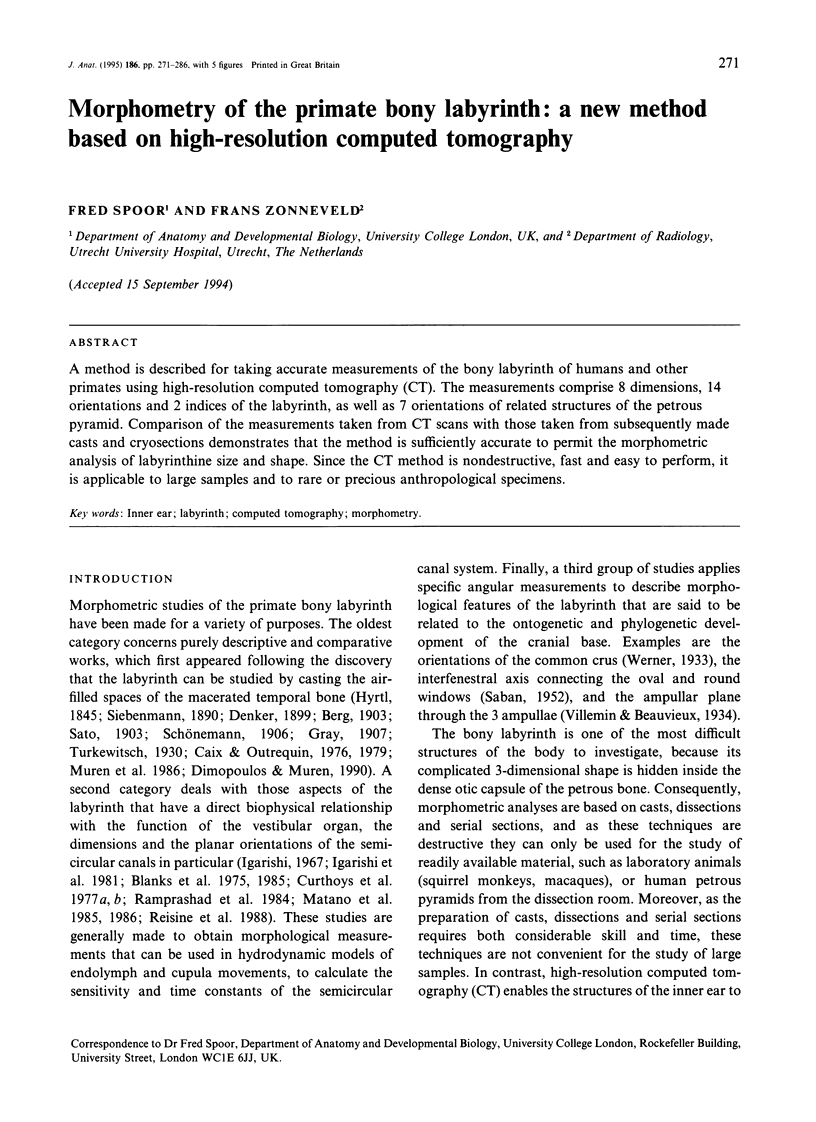
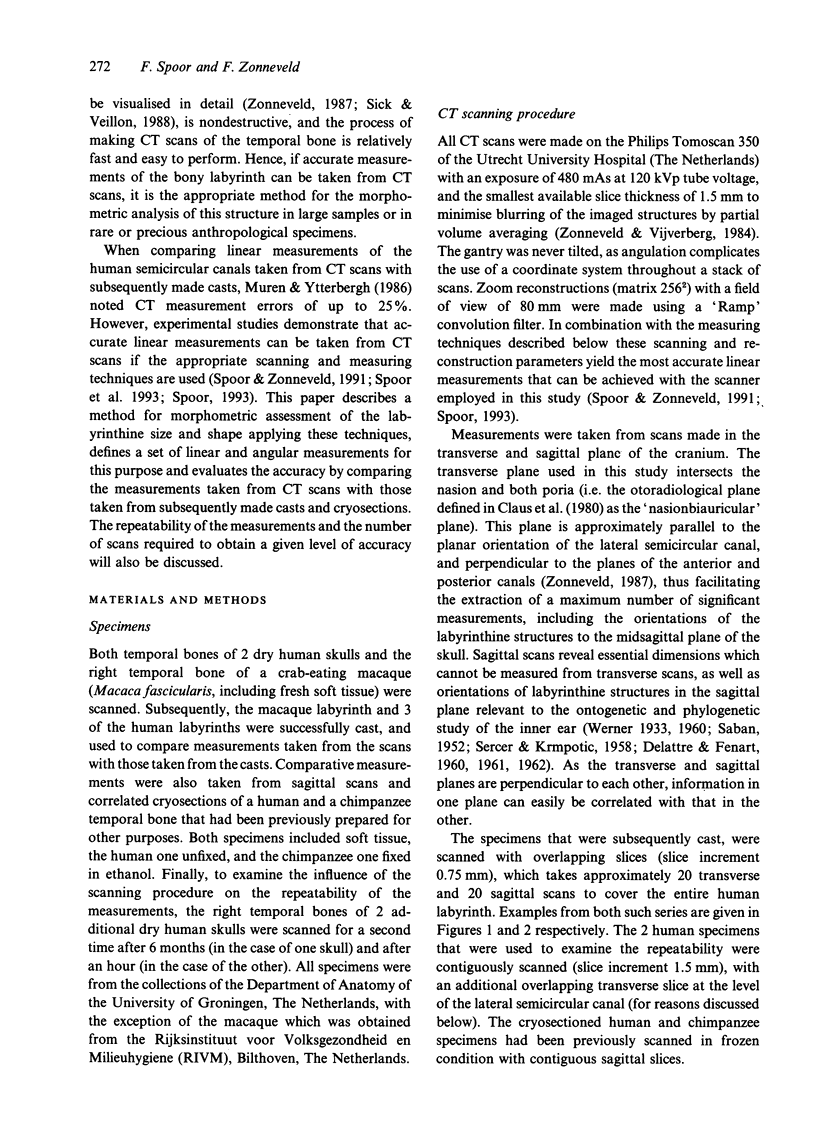
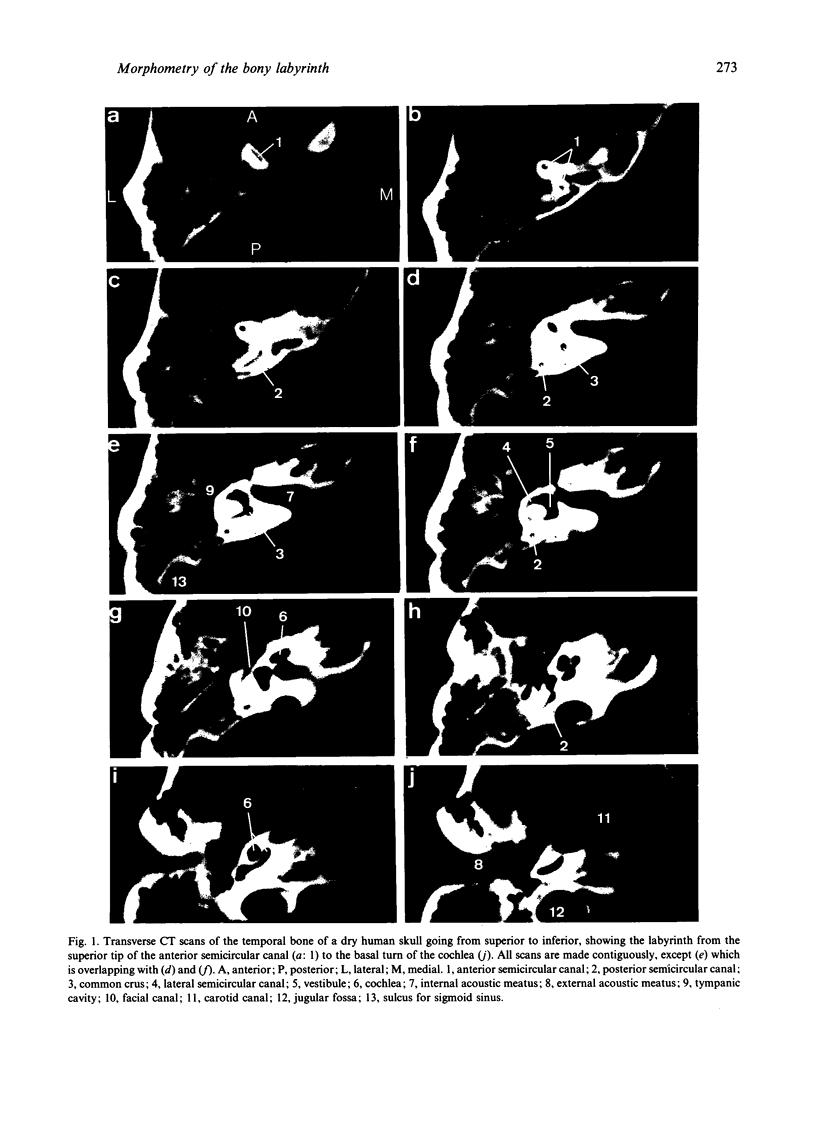

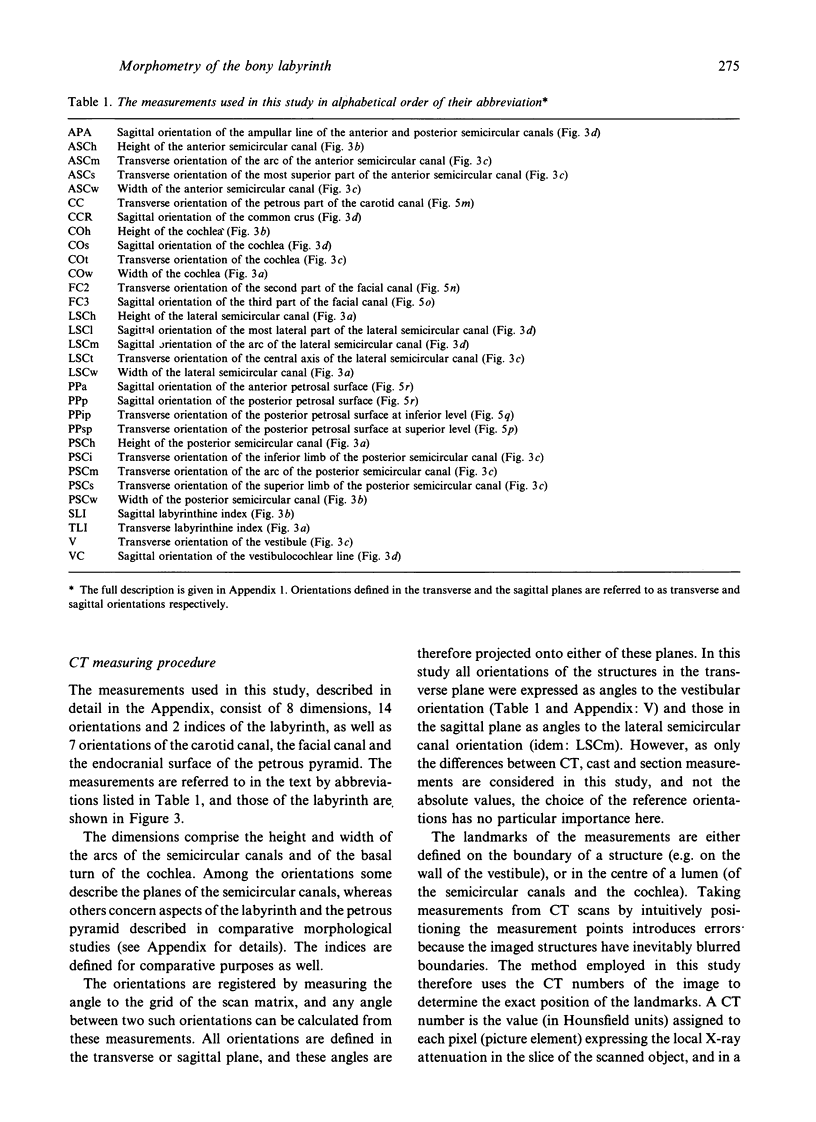
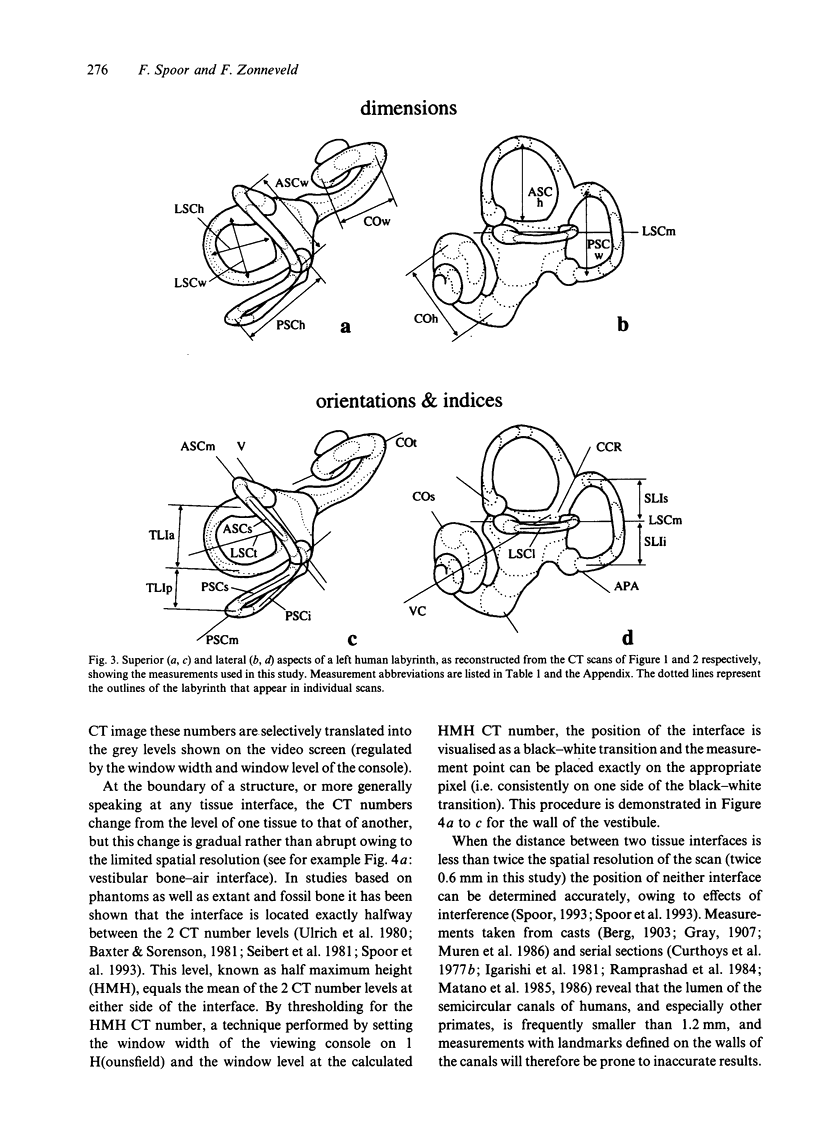
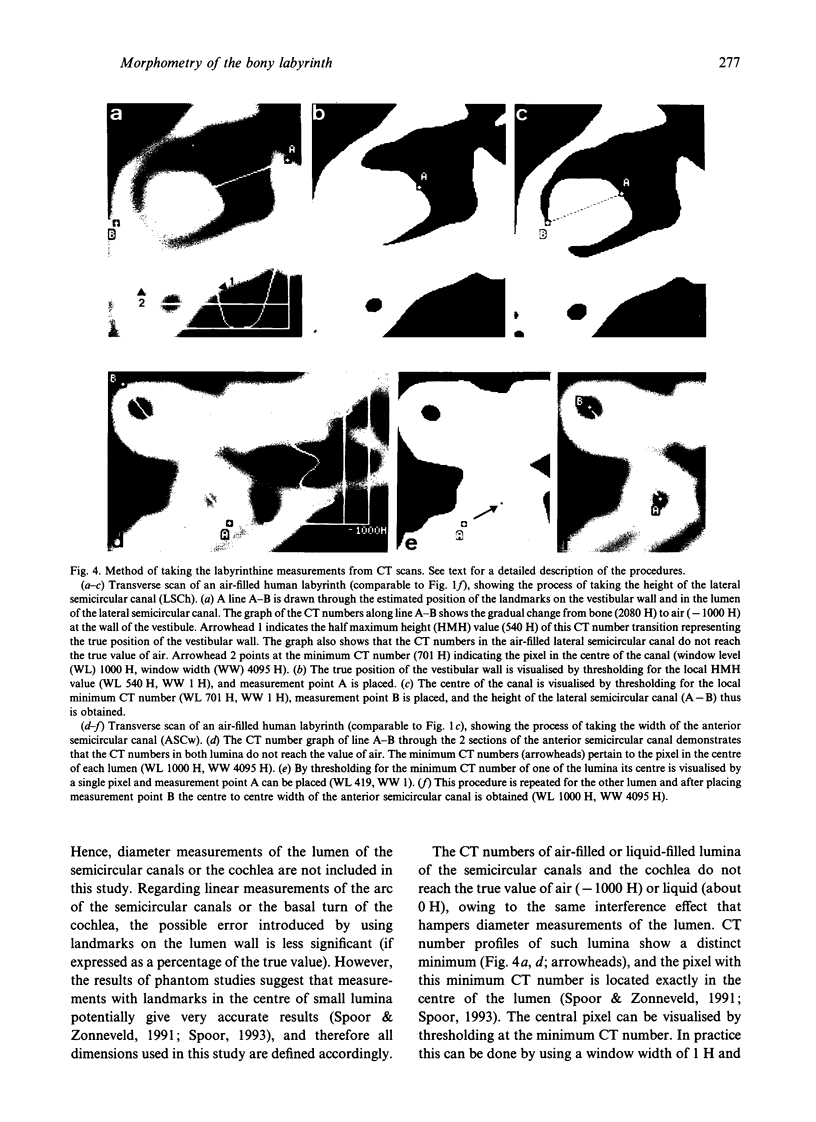
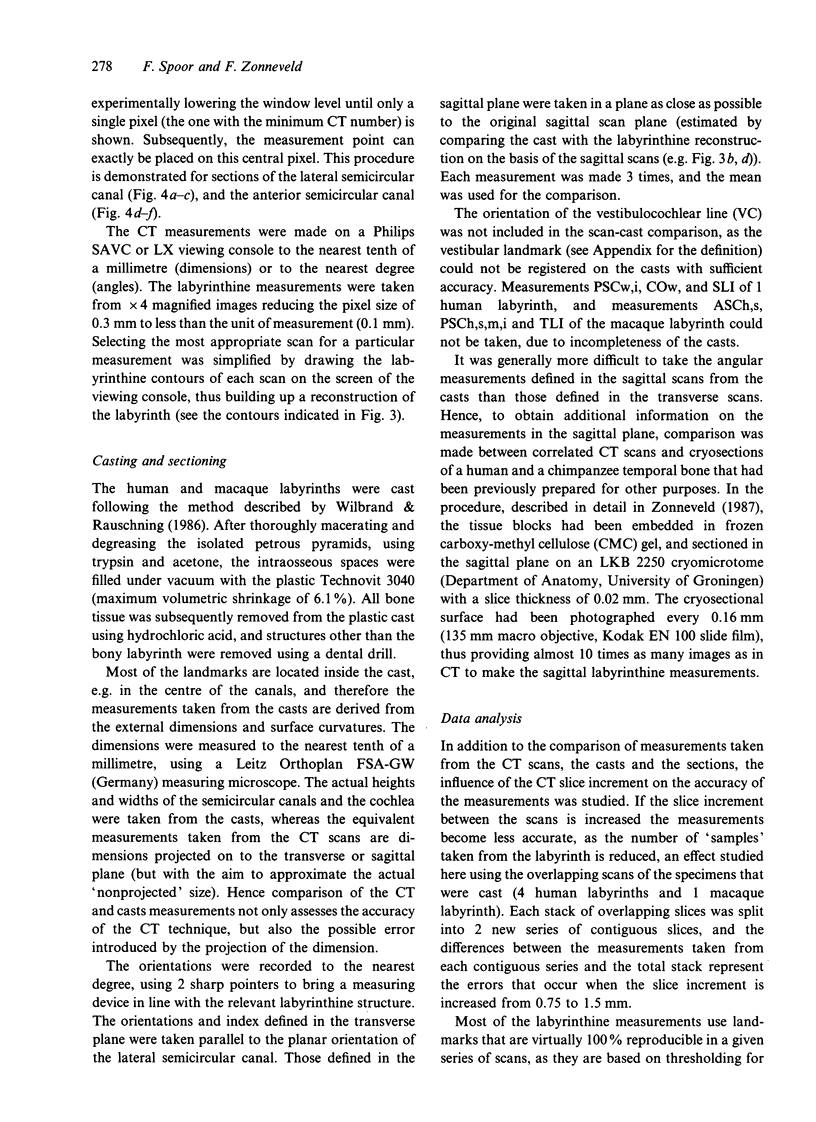
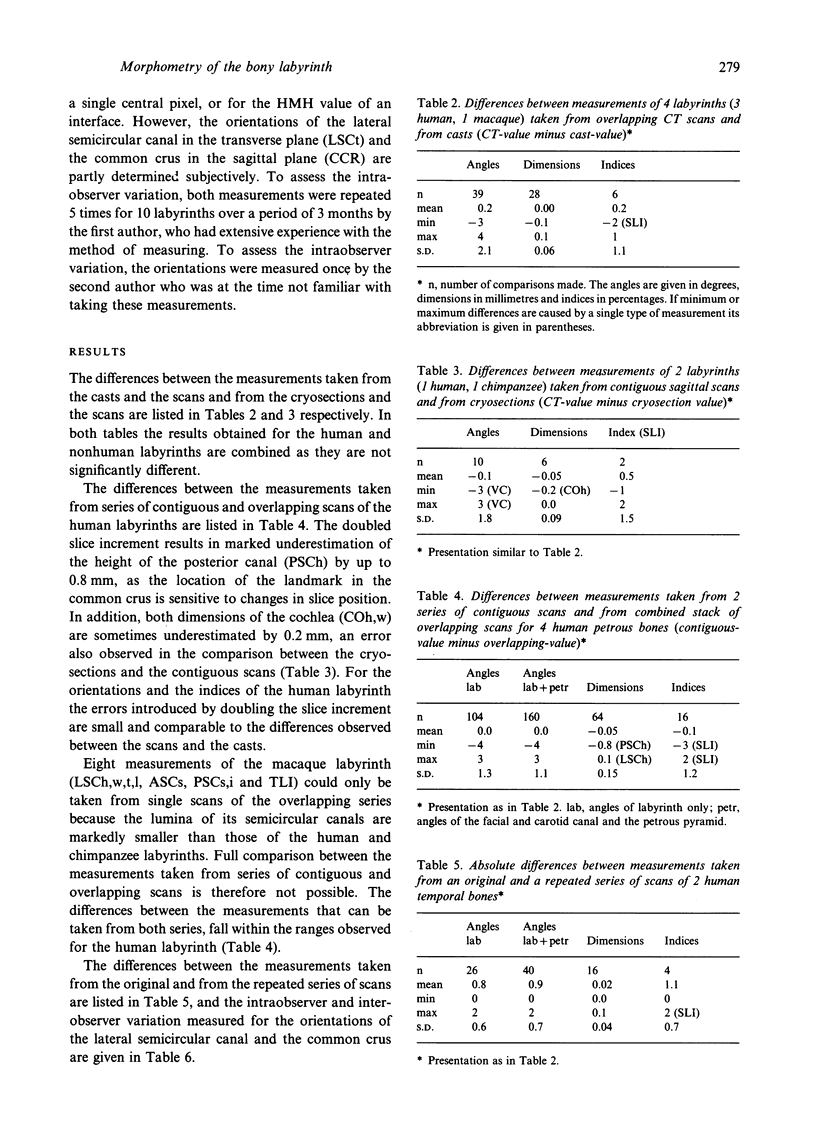

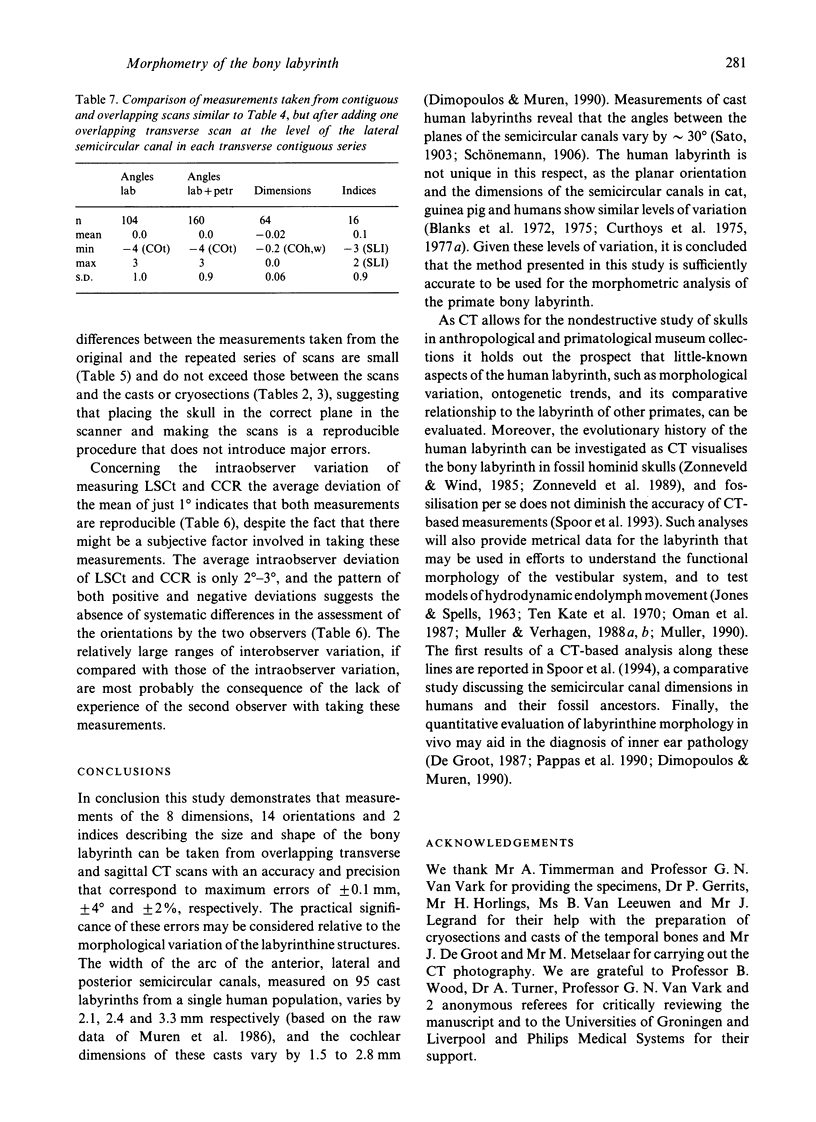

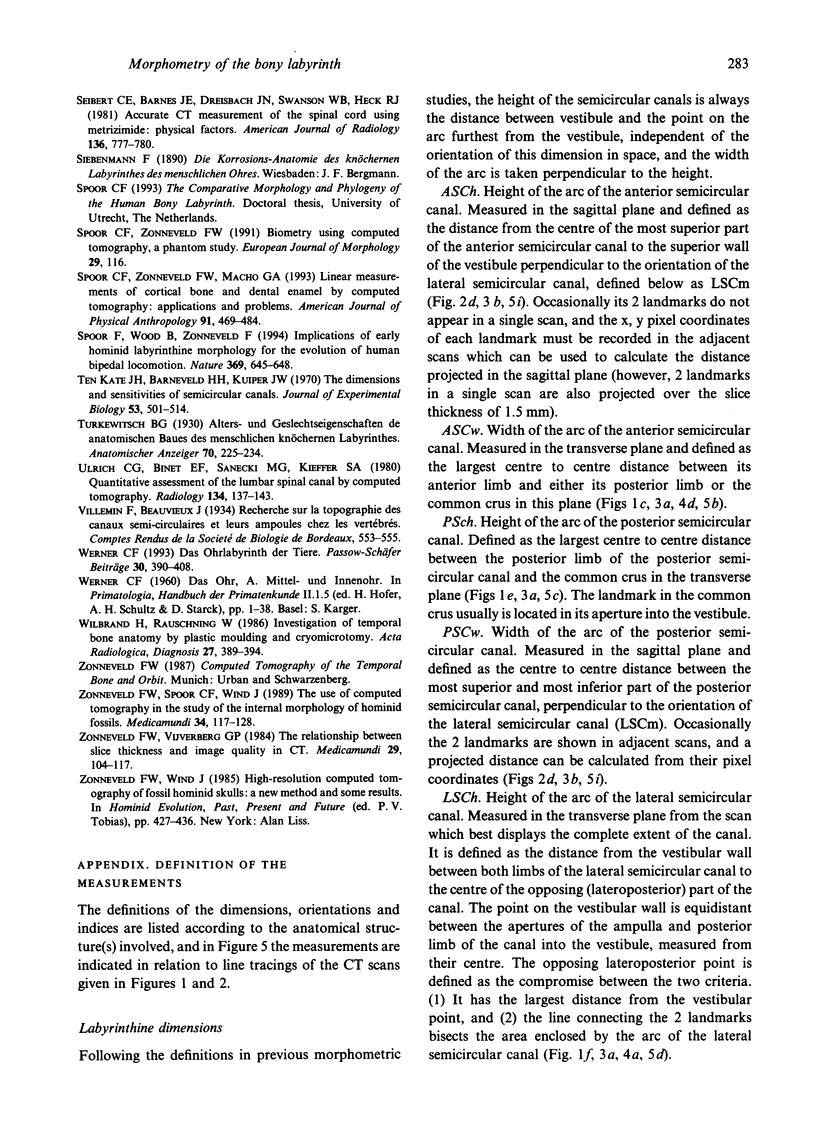
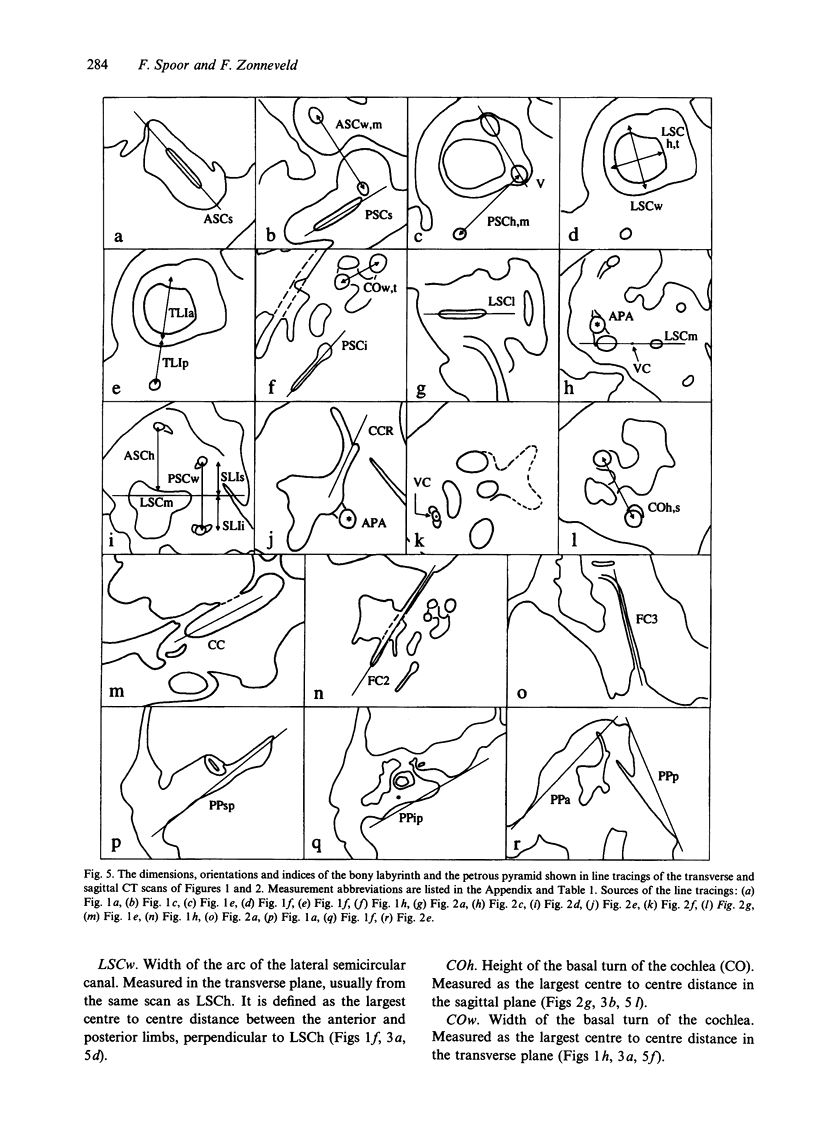
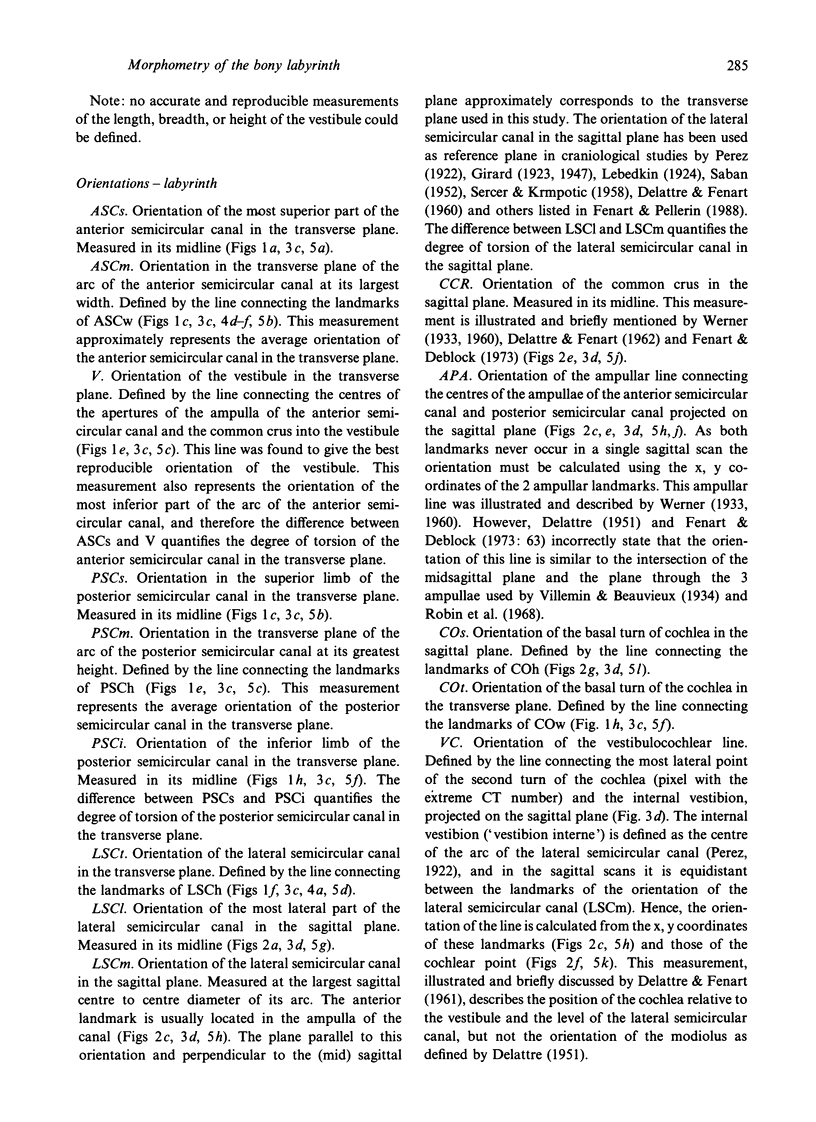
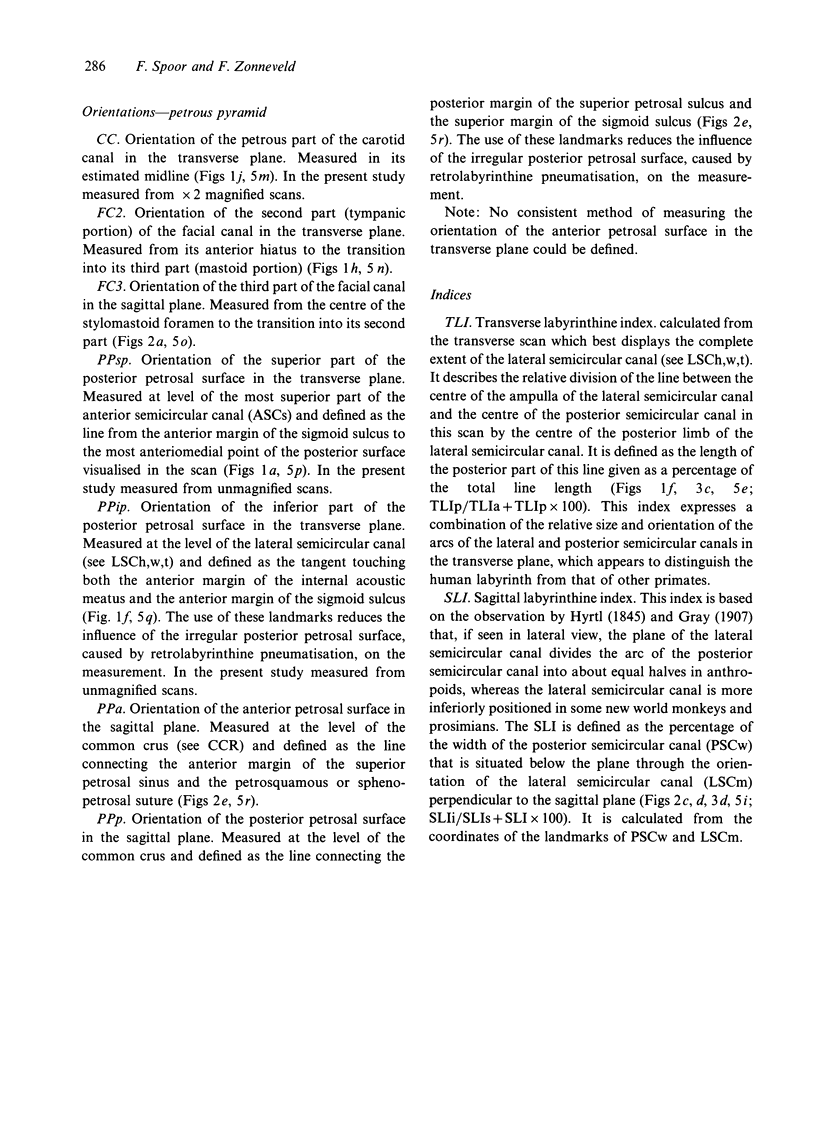
Images in this article
Selected References
These references are in PubMed. This may not be the complete list of references from this article.
- Baxter B. S., Sorenson J. A. Factors affecting the measurement of size and CT number in computed tomography. Invest Radiol. 1981 Jul-Aug;16(4):337–341. doi: 10.1097/00004424-198107000-00017. [DOI] [PubMed] [Google Scholar]
- Blanks R. H., Curthoys I. S., Bennett M. L., Markham C. H. Planar relationships of the semicircular canals in rhesus and squirrel monkeys. Brain Res. 1985 Aug 12;340(2):315–324. doi: 10.1016/0006-8993(85)90928-x. [DOI] [PubMed] [Google Scholar]
- Blanks R. H., Curthoys I. S., Markham C. H. Planar relationships of semicircular canals in the cat. Am J Physiol. 1972 Jul;223(1):55–62. doi: 10.1152/ajplegacy.1972.223.1.55. [DOI] [PubMed] [Google Scholar]
- Blanks R. H., Curthoys I. S., Markham C. H. Planar relationships of the semicircular canals in man. Acta Otolaryngol. 1975 Sep-Oct;80(3-4):185–196. doi: 10.3109/00016487509121318. [DOI] [PubMed] [Google Scholar]
- Claus E., Lemahieu S. F., Ernould D. The most used otoradiological projections. J Belge Radiol. 1980;63(2-3):183–203. [PubMed] [Google Scholar]
- Curthoys I. S., Curthoys E. J., Blanks R. H., Markham C. H. The orientation of the semicircular canals in the guinea pig. Acta Otolaryngol. 1975 Sep-Oct;80(3-4):197–205. doi: 10.3109/00016487509121319. [DOI] [PubMed] [Google Scholar]
- Curthoys I. S., Markham C. H., Curthoys E. J. Semicircular duct and ampulla dimensions in cat, guinea pig and man. J Morphol. 1977 Jan;151(1):17–34. doi: 10.1002/jmor.1051510103. [DOI] [PubMed] [Google Scholar]
- DELATTRE A. La rotation vestibulaire. C R Hebd Seances Acad Sci. 1951 Oct 22;233(17):978–980. [PubMed] [Google Scholar]
- Dimopoulos P., Muren C. Anatomic variations of the cochlea and relations to other temporal bone structures. Acta Radiol. 1990 Sep;31(5):439–444. [PubMed] [Google Scholar]
- Igarashi M. Dimensional study of the vestibular apparatus. Laryngoscope. 1967 Oct;77(10):1806–1817. doi: 10.1288/00005537-196710000-00003. [DOI] [PubMed] [Google Scholar]
- Igarashi M., O-Uchi T., Alford B. R. Volumetric and dimensional measurements of vestibular structures in the squirrel monkey. Acta Otolaryngol. 1981 May-Jun;91(5-6):437–444. doi: 10.3109/00016488109138525. [DOI] [PubMed] [Google Scholar]
- JONES G. M., SPELLS K. E. A theoretical and comparative study of the functional dependence of the semicircular canal upon its physical dimensions. Proc R Soc Lond B Biol Sci. 1963 Mar 26;157:403–419. doi: 10.1098/rspb.1963.0019. [DOI] [PubMed] [Google Scholar]
- Muller M., Verhagen J. H. A mathematical approach enabling the calculation of the total endolymph flow in the semicircular ducts. J Theor Biol. 1988 Oct 21;134(4):503–529. doi: 10.1016/s0022-5193(88)80054-7. [DOI] [PubMed] [Google Scholar]
- Muller M., Verhagen J. H. A new quantitative model of total endolymph flow in the system of semicircular ducts. J Theor Biol. 1988 Oct 21;134(4):473–501. doi: 10.1016/s0022-5193(88)80053-5. [DOI] [PubMed] [Google Scholar]
- Muren C., Ruhn G., Wilbrand H. Anatomic variations of the human semicircular canals. A radioanatomic investigation. Acta Radiol Diagn (Stockh) 1986 Mar-Apr;27(2):157–163. doi: 10.1177/028418518602700205. [DOI] [PubMed] [Google Scholar]
- Muren C., Ytterbergh C. Computed tomography of temporal bone specimens. A test of the resolution capability. Acta Radiol Diagn (Stockh) 1986 Nov-Dec;27(6):645–651. doi: 10.1177/028418518602700605. [DOI] [PubMed] [Google Scholar]
- Oman C. M., Marcus E. N., Curthoys I. S. The influence of semicircular canal morphology on endolymph flow dynamics. An anatomically descriptive mathematical model. Acta Otolaryngol. 1987 Jan-Feb;103(1-2):1–13. doi: 10.3109/00016488709134691. [DOI] [PubMed] [Google Scholar]
- Pappas D. G., Simpson L. C., McKenzie R. A., Royal S. High-resolution computed tomography: determination of the cause of pediatric sensorineural hearing loss. Laryngoscope. 1990 Jun;100(6):564–569. doi: 10.1288/00005537-199006000-00002. [DOI] [PubMed] [Google Scholar]
- Ramprashad F., Landolt J. P., Money K. E., Laufer J. Dimensional analysis and dynamic response characterization of mammalian peripheral vestibular structures. Am J Anat. 1984 Mar;169(3):295–313. doi: 10.1002/aja.1001690306. [DOI] [PubMed] [Google Scholar]
- Reisine H., Simpson J. I., Henn V. A geometric analysis of semicircular canals and induced activity in their peripheral afferents in the rhesus monkey. Ann N Y Acad Sci. 1988;545:10–20. doi: 10.1111/j.1749-6632.1988.tb19552.x. [DOI] [PubMed] [Google Scholar]
- SERCER A., KRAMPOTIC J. Further contribution to the development of the labyrinthine capsule. J Laryngol Otol. 1958 Sep;72(9):688–698. [PubMed] [Google Scholar]
- Seibert C. E., Barnes J. E., Dreisbach J. N., Swanson W. B., Heck R. J. Accurate CT measurement of the spinal cord using metrizamide: physical factors. AJR Am J Roentgenol. 1981 Apr;136(4):777–780. doi: 10.2214/ajr.136.4.777. [DOI] [PubMed] [Google Scholar]
- Spoor C. F., Zonneveld F. W., Macho G. A. Linear measurements of cortical bone and dental enamel by computed tomography: applications and problems. Am J Phys Anthropol. 1993 Aug;91(4):469–484. doi: 10.1002/ajpa.1330910405. [DOI] [PubMed] [Google Scholar]
- Spoor F., Wood B., Zonneveld F. Implications of early hominid labyrinthine morphology for evolution of human bipedal locomotion. Nature. 1994 Jun 23;369(6482):645–648. doi: 10.1038/369645a0. [DOI] [PubMed] [Google Scholar]
- Ullrich C. G., Binet E. F., Sanecki M. G., Kieffer S. A. Quantitative assessment of the lumbar spinal canal by computed tomography. Radiology. 1980 Jan;134(1):137–143. doi: 10.1148/radiology.134.1.7350593. [DOI] [PubMed] [Google Scholar]
- Wilbrand H., Rauschning W. Investigation of temporal bone anatomy by plastic moulding and cryomicrotomy. Acta Radiol Diagn (Stockh) 1986 Jul-Aug;27(4):389–394. doi: 10.1177/028418518602700404. [DOI] [PubMed] [Google Scholar]
- ten Kate J. H., van Barneveld H. H., Kuiper J. W. The dimensions and sensitivities of semicircular canals. J Exp Biol. 1970 Oct;53(2):501–514. doi: 10.1242/jeb.53.2.501. [DOI] [PubMed] [Google Scholar]





